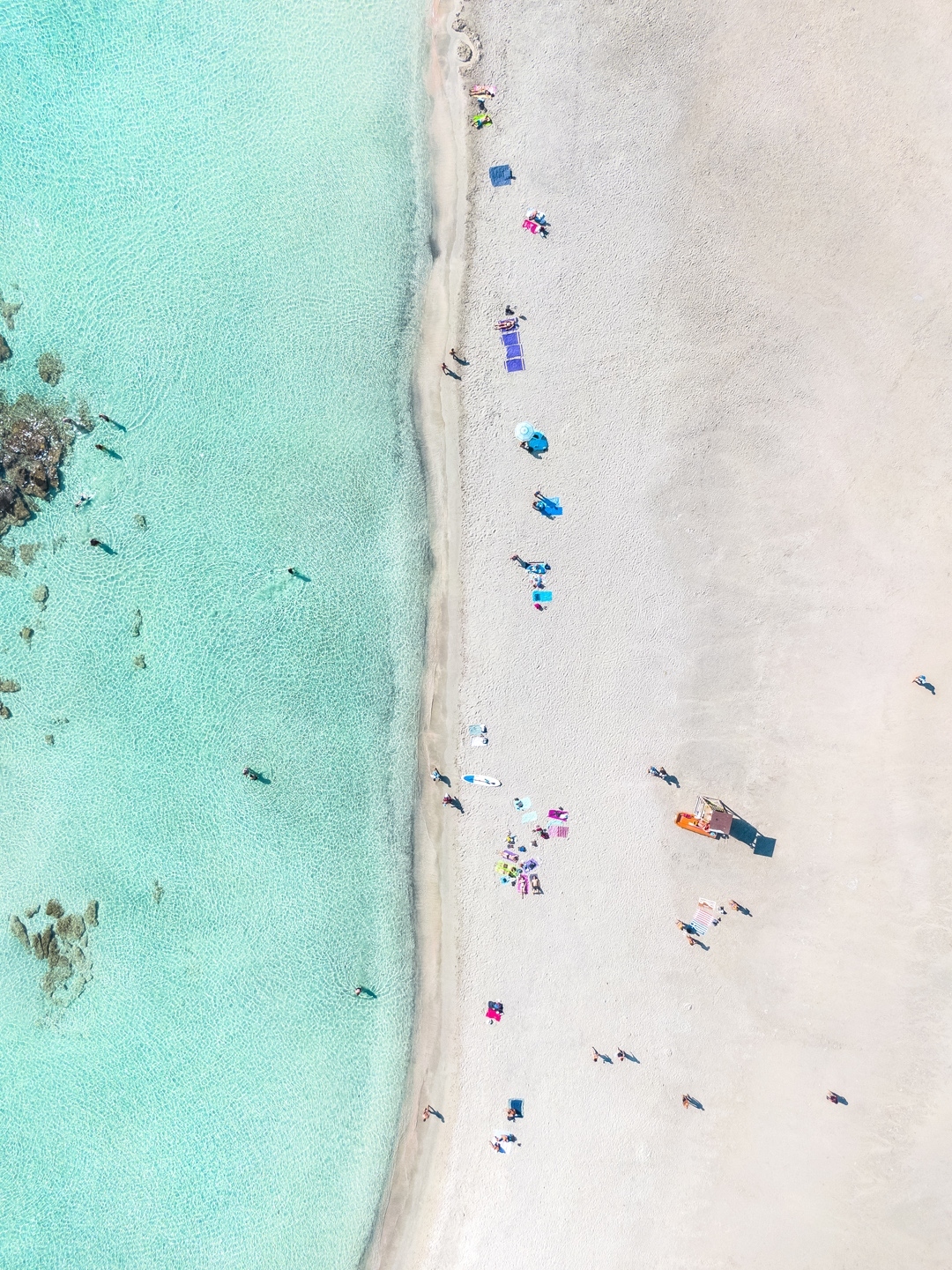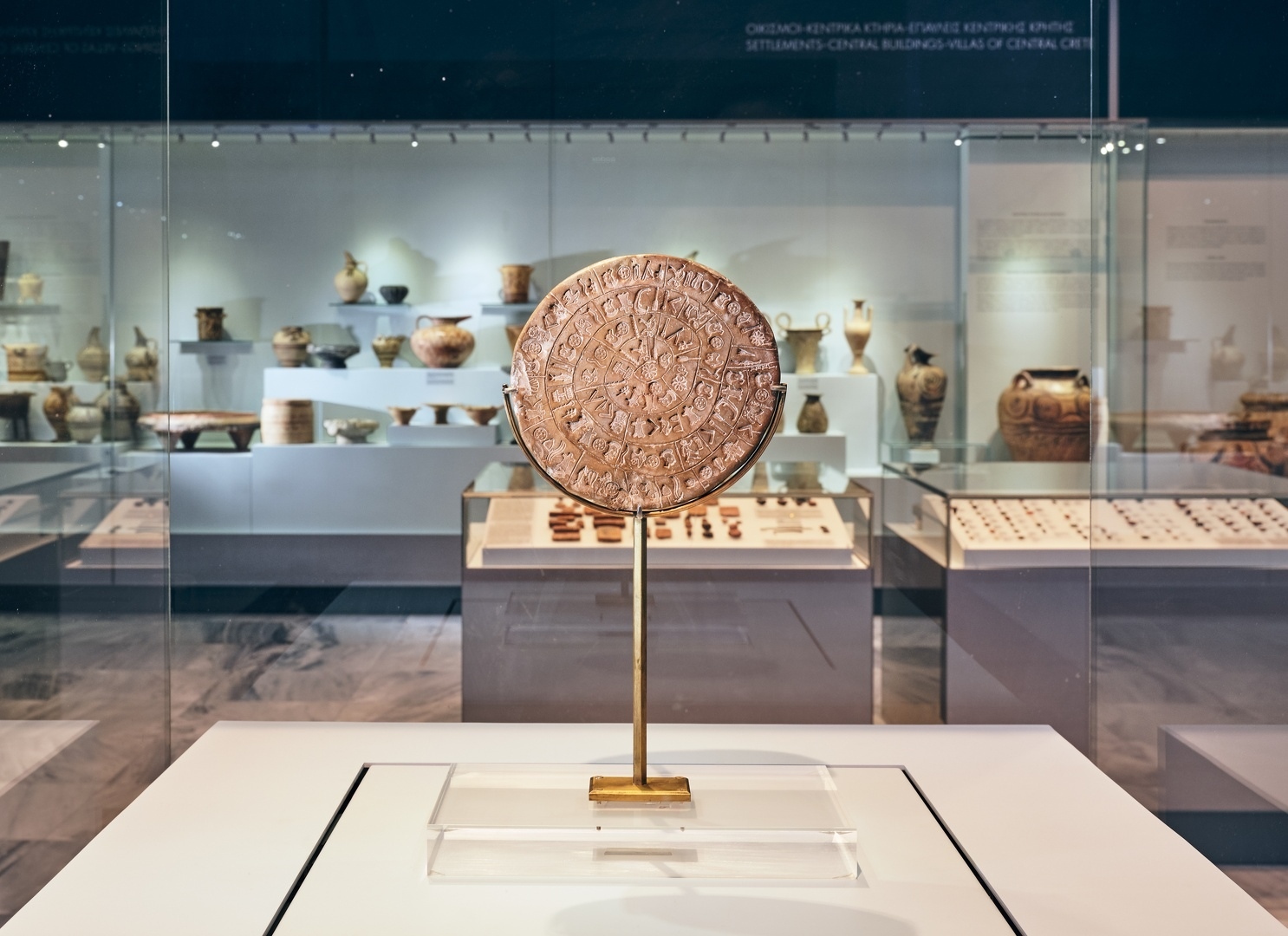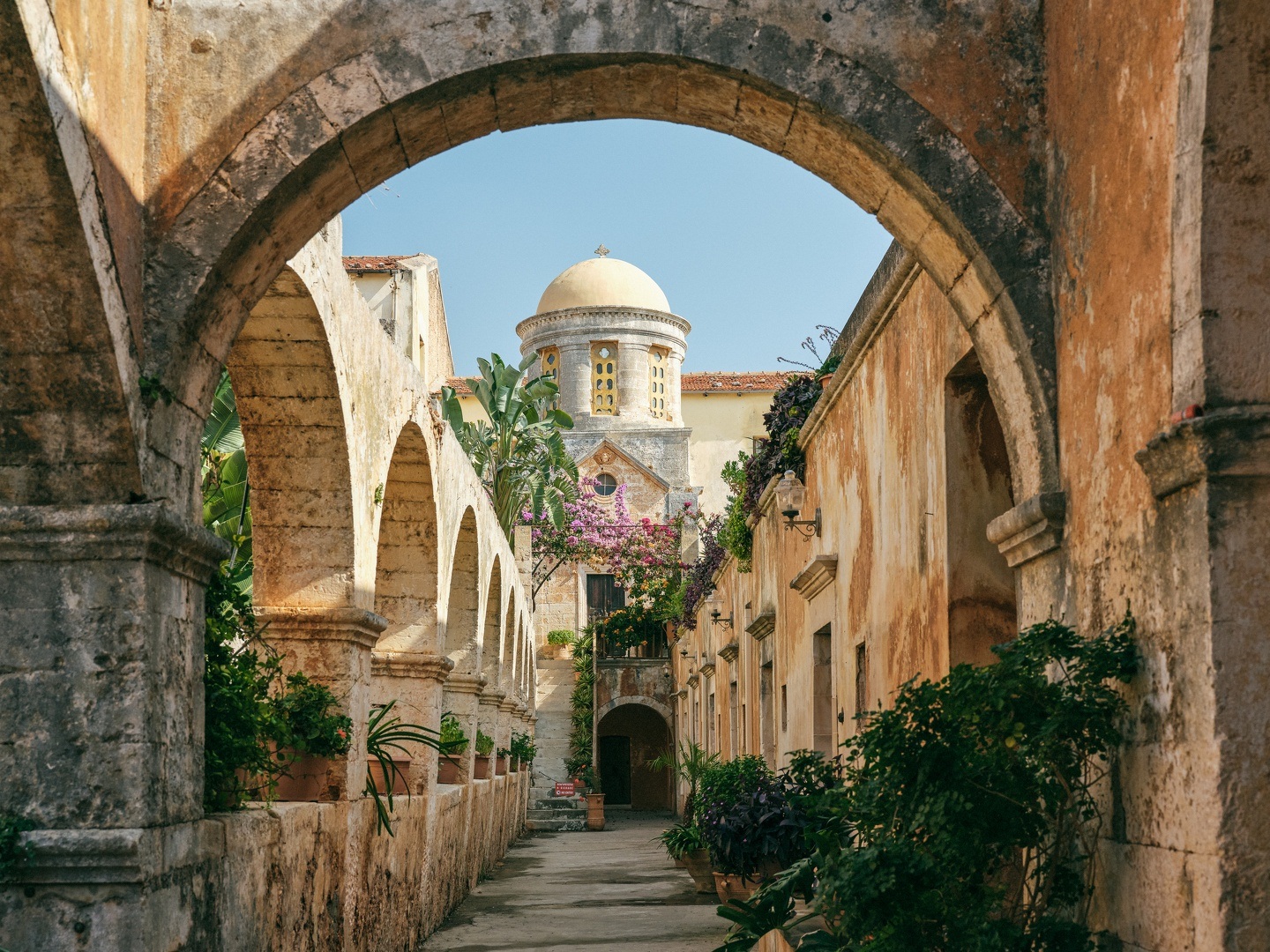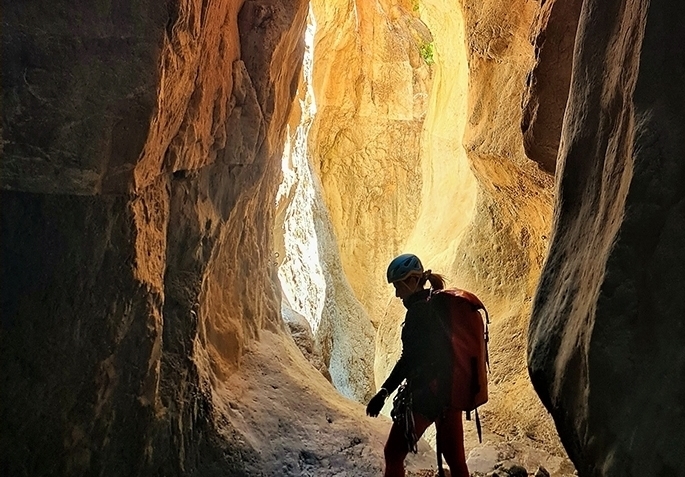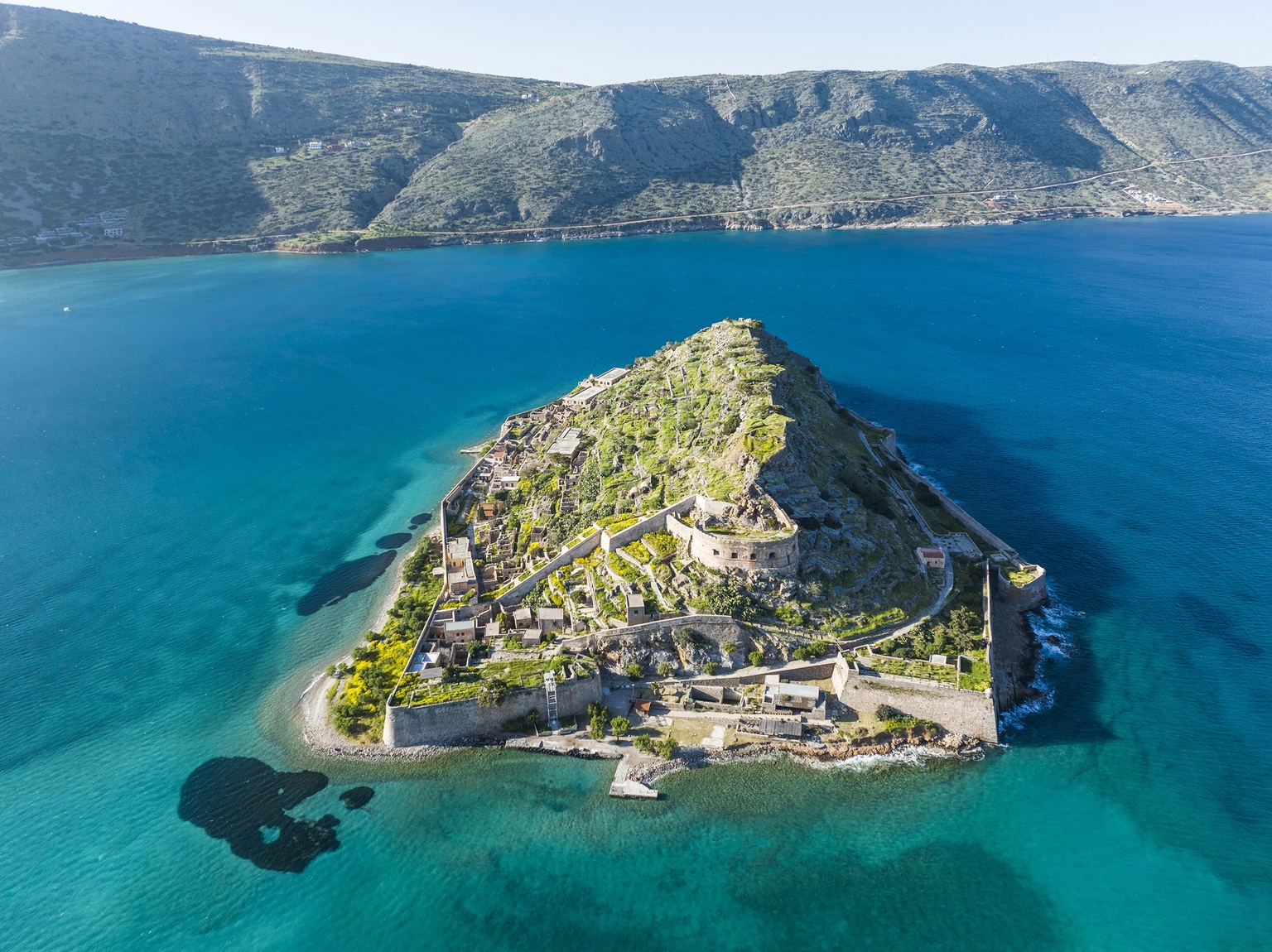12 Treasures at the Nikos Kazantzakis Museum
Author Discover Crete
Culture
Culture
Latest news
- A Cinematic Journey from Gramvousa to Balos
- The Orange Festival returns to Fodele!
- Chrissi Island: Protection Measures Continue in 2025 to Preserve a True Paradise
- You Can — You Just Don’t Know It Yet! Adventure in Crete with Crete on the Rocks
- Excursion to the Limnakaro Plateau with the Mountaineering Club of Heraklion
Located in Varvari or Myrtia, a beautiful village within the Municipality of Archanes, Asterousia, lies the Nikos Kazantzakis Museum.
In its halls, the museum showcases 12 treasures:
- The original manuscript of ‘The Ascent’
- The Mt Athos Notebook-Calendar
- Handwritten drafts of Kazantzakis' ‘Odyssey’
- A collector's first edition of 'Life and Times of Alexis Zorbas'
- The screenplay by Anthony Quinn for the film ‘Zorba the Greek’
- Costume designs by G Tsarouchis for the film ‘Christ Recrucified
- Costume designs for the theatrical production of ‘Sodom and Gomorrah’
- Artefacts from the Spanish Civil War
- A portrait-sketch of Kazantzakis by Fotis Kontoglou
- A life-sized terracotta figure of Kazantzakis
- A photo album featuring Nikos Kazantzakis in Crete in 1945
- Kazantzakis' Cretan ‘vourgiali’ (rucksack)


The manuscript ‘The Ascent’ is preserved in the Kazantzakis Museum and is a hidden gem that literally came out of the drawer, as since 2010 copies of its first pages were included in the documents of the Museum's re-exhibition and were included in the ‘Drawers’ section, where there were documents that needed further investigation. The manuscript was found in the belongings of George Anemogiannis, founder of the Museum, along with other important and unknown until then documents, which have emerged in recent years.
The initial recording of the then unidentified manuscript known as ‘The Ascent’ dates back to 2007, coinciding with the Museum's efforts to preserve and digitise its valuable materials. During this period, the manuscript underwent its first scientific documentation and cataloguing. Although ‘The Ascent’ was classified among these materials, there was uncertainty regarding its completeness, and no title had been attributed to it at that time. However, the original documentation of the manuscript contained references suggesting that parts of it had been utilised by Kazantzakis in other works. Additionally, Eleni Kazantzaki had reportedly described it as a disavowed piece of literature.
In 2016, the manuscript was initially identified as the elusive lost work, ‘The Ascent’. Subsequently, in 2017, it journeyed to Athens as part of an anniversary tribute during the Kazantzakis Year. The following year, in 2018, it was unveiled to the academic community for the first time. Fast forward to October 2022, the manuscript was officially published in book form, marking its debut to the public at the Kazantzakis Museum. Now, the entire manuscript is prominently showcased in a thematic temporary exhibition. Once the exhibition concludes, the manuscript will find its place among the exhibits of the Museum's Permanent Exhibition.
Nikos Kazantzakis' ‘The Ascent’ was penned over the course of nearly a month, during August 1946 in Cambridge, England. Remarkably, this work shares striking resemblances with ‘Captain Michalis’ and various other compositions by the author, whether preceding or succeeding it in publication.
With its publication and rapid dissemination, ‘The Ascent’ swiftly ascended to the pinnacle of bestseller lists in newspapers, igniting a renewed fascination with the works of Nikos Kazantzakis. The Kazantzakis Museum, through its unveiling of the discovered manuscript, emerges as a bastion of preservation and promotion for documents associated with the esteemed author's life and literary legacy.


One of the most significant figures in Nikos Kazantzakis' life was Angelos Sikelianos, whom he regarded as a profound visionary. Their legendary companionship commenced in November 1914 when they first met at the offices of the Educational Society in Athens, where they immediately recognised a kindred spiritual connection. Within days, they embarked on a transformative forty-day pilgrimage to Mt Athos, envisioning the establishment of a new religion while delving into the works of Tolstoy, Buddha, and Dante. The following year, their explorations extended to other regions of central Greece. Kazantzakis frequently found hospitality at Sikelianos' residence in Sykia, Corinth, nurturing a relationship marked by profound depths and occasional challenges along the way.
Their journey, beginning with their now historic visit to the Garden of the Virgin Mary, held profound significance for both Nikos Kazantzakis and Angelos Sikelianos. Each meticulously documented their impressions in their personal diaries, a fortunate circumstance as both accounts have been preserved and subsequently published. While the Sikelianos Diary is housed in the Manuscripts and Facsimiles Department of the National Library of Greece, Kazantzakis' Diary finds its home in the Kazantzakis Museum, ensuring that their invaluable insights continue to be accessible to future generations.
This diary is one of the author's earliest and most cherished possessions, crafted within a special notebook, a common choice for financial record-keeping in the preceding centuries. Measuring a mere 11×16.4 cm per page, each sheet bears numbering in the upper right corner, marking the recto. The notebook contains handwritten entries on both sides of its cover and back cover, comprising a total of 118 handwritten pages. Predominantly inscribed in pencil, occasional variations are observed with handwritten notes in black and blue ink, possibly added later. Throughout the text, deletions, underlining, and highlights in red or blue ink, in line with Kazantzakis' customary practice, offer further insight into his thought and revisions. Particularly intriguing are the accompanying sketches, including detailed maps of Chalkidiki and the Athos Peninsula at the outset of the diary, meticulously outlining their journey's route.
This Diary is part of the author's diary collection, entrusted to the Museum by George Anemogiannis. Eleni Kazantzakis entrusted the Diary, along with other significant documents, to Anemogiannis, presumably recognising their importance as museum exhibits. In 1983, during her speech at the Museum's opening ceremony, Eleni Kazantzakis expressed her gratitude and confidence in Anemogiannis' dedication, remarking that ‘there is no person in the world who has worked with greater love for a work that he believes in, like Mr Anemogiannis.’ A few years later, in 1988, both attended and were named honorary members of the International Society of Friends of Nikos Kazantzakis during a gathering in Geneva, aimed at promoting the thought and works of Nikos Kazantzakis.
The Calendar of Mt Athos, and its meticulous examination in recent years, has shed light on a somewhat overlooked facet of the author: that of a systematic diarist. This exploration has unveiled a type of text whose thorough analysis can unveil truly undiscovered and concealed treasures of Nikos Kazantzakis' philosophy. His more intimate writings, including his diaries and letters, offer us a deeper glimpse into the mind and persona behind the myth, drawing us closer to the essence of the creator himself.
The book was published by the Nikos Kazantzakis Museum in 2020.


George Stasinakis, a longstanding President of the International Society of Friends of Nikos Kazantzakis and Honorary Member of the Museum's Board of Directors, has been instrumental in advancing the Museum's mission since its inception. Notably, his contributions include enriching the Museum's Collections with significant artefacts, such as the author's table from his residence in Antip, France, and the manuscripts of ‘Odyssey’. Additionally, he has facilitated the acquisition and preservation of numerous other documents displayed or archived within the institution.
In 2008 George Stasinakis happily handed over the two volumes of the script of Kazantzakis' ‘Odyssey’ to the Nikos Kazantzakis Museum. These volumes have been exhibited since the renovation of the Museum on the author's table, in the room dedicated to ‘Odyssey’.
These two hardback volumes, measuring 22x14x4.7 cm each, contain approximately 1,000 pages per volume, meticulously numbered by the author. They comprise the complete manuscript of Nikos Kazantzakis' ‘Odyssey’, dating back to 1929-1931, and hold immense importance for scholarly analysis. Notably, the manuscripts exhibit two distinct types of handwriting: the body of the rhapsodies appears to have been transcribed by Eleni Kazantzaki, while corrections, additions, and page annotations are attributed to Nikos Kazantzakis himself.
The first volume, labelled 'ODYCEIA I / second script' with annotations indicating 'there will be 7 scripts’, (meaning ‘revisions’) features rhapsodies A to M alongside corrections and additions for rhapsodies N, O, Y, and F. Additionally, the second volume, marked 'ODYCEIA II / c to d script’, contains complete rhapsodies N to Z and provides further corrections and additions for rhapsodies A to M, cross-referencing the corresponding pages in the first volume, i.e., the second script.
It is well documented that Nikos Kazantzakis subjected his literary works to successive revisions, resulting in different versions or ‘scripts’ over time. His magnum opus, ‘Odyssey’, underwent a rigorous creative process spanning thirteen years, from 1925 to 1938, with even more extensive research preceding its actual writing. The dedication, relentless effort, and unwavering determination towards completing this monumental work are eloquently conveyed in the frontispiece of the ‘second provisional script’. Here, Kazantzakis inscribes the poignant phrase ‘ostinato rigore’ (persistent rigour) attributed to Leonardo da Vinci, followed by his own declaration: ‘desperate and unyielding’.
‘Odyssey’, consisting of 33,333 verses, was published in 1938 by Pyrsos Publications in a substantial volume, spanning 835 pages. Noteworthy are the specially crafted typographic elements employed in the publication, along with a 10-page insert featuring a Vocabulary section. This edition was dedicated to Miss Joe MacLeod, the generous sponsor of the publication. However, to this day, the whereabouts of the remaining scripts, presumed to contain further enhancements to sections of ‘Odyssey’, remain unknown. Regrettably, none of these additional manuscripts have been subjected to systematic study, leaving a significant gap in our understanding of Kazantzakis' creative process.


In the autumn of 2016, the Kazantzakis Museum came across a rare copy of the first edition of the iconic novel ‘Life and Times of Alexis Zorbas’ (subsequently titled ‘Zorba the Greek’ in English) at an auction house. Prompted by Stelios Matzapetakis, then chairman of the Museum's Board of Directors, businessman Spyros Kokotos purchased the book. At the subsequent handover ceremony, Kokotos generously donated the item to the Museum, expressing, ‘Of course, I donate it to the Museum, since I believe that this is its rightful place, not on the shelf of a library.’
The significance of this collector's copy lies in its numerous corrections and additions, meticulously made by the author himself in preparation for the second edition of the work. Additionally, it features a new arrangement of the text into 25 typographical documents, compared to 22 in the first edition. The heightened value of this edition was evidenced by the robust buying interest it garnered; despite an initial estimate of up to 3,500 euros, it ultimately fetched double that amount at auction.
Undoubtedly, the novel ‘Life and Times of Alexis Zorbas’ is the author's most renowned and extensively translated work. It served as his introduction to the international audience, acting as a passport to global recognition and giving rise to one of his most iconic characters. Remarkably, it is the author's first known novel and the only one written in Greece and in Greek before his eventual departure abroad.
‘Life and Times of Alexis Zorbas’ was written in Aegina in 1941. It was completed in 1943, and first published by Dimitrakos Publications in 1946. Its publication coincided with Kazantzakis' departure to England, following his travels during the same summer at the invitation of the British Council. While settled in Cambridge, recent research indicates that Kazantzakis wrote the previously unknown novel ‘The Ascent’ at lightning speed, just a few months, before ‘Life and Times of Alexis Zorbas’ was even published in Greece and, of course, before it was translated and published abroad. Indeed, the tremendous success of ‘Life and Times of Alexis Zorbas’ and the immediate response of the foreign public to translations of the work lead to speculation that this success may have been one of the reasons why ‘The Ascent’ remained unpublished.
The meticulous examination of this unique copy holds significant interest, particularly regarding the author's stylistic choices. It serves as a valuable witness, offering a charming glimpse into his creative process—a sneak peek into his ‘workshop’, if you will. The second edition of the book was published several years later, in 1954, incorporating some of Kazantzakis' corrections. However, certain corrections made their way into subsequent editions, while others were eventually removed by publishers. Therefore, the comparison and comparative examination of all editions and reprints of the work become even more intriguing, especially in the quest to uncover the author's intent.
In the early stages of establishing the Kazantzakis Museum, George Anemogiannis prioritised the task of sourcing and compiling material related to various adaptations of ‘Zorba the Greek’ across different mediums worldwide, including cinema, theatre, and musicals. By 1979, he had already amassed relevant material from theatrical performances and musical adaptations of ‘Zorba the Greek’ staged in Europe, while also establishing connections with producers in the USA. Notably, among the extensive collection preserved by Anemogiannis, one standout piece is the script of Michael Cacoyannis' acclaimed film ‘Zorba the Greek’.
Following their collaboration in London for BBC radio broadcasts shortly after World War II, Kazantzakis and Cacoyannis maintained sporadic correspondence over the years. Their paths crossed again in 1954 at the Cannes Film Festival, where they attended screenings together in Kazantzakis' box. During this time, Kazantzakis expressed his desire to see one of his plays adapted for the cinema, with Cacoyannis as the director. Nine years later, Kazantzakis' wish became a reality.
Cacoyannis could now afford to produce ‘Zorba the Greek’ himself and had managed to solve the script's problems that had discouraged many other creators from attempting to adapt Kazantzakis' book for the cinema. The film was shot in Crete in 1964 and distributed by 20th Century Fox.
The reviews for the film were overwhelmingly positive, praising Cacoyannis' excellent direction and script, the nuanced performances of the protagonists, and, of course, the unforgettable music by Mikis Theodorakis. At the 37th Academy Awards in 1965, the film received seven nominations, including Best Picture, Best Actor, Best Director, Best Screenplay, Best Supporting Actress, Best Black and White Cinematography, and Best Black and White Set Design, winning the last three. Additionally, it garnered five Golden Globe nominations and four BAFTA Award nominations. Mikis Theodorakis was also nominated for a Grammy Award in the category of Best Music Written for a Motion Picture. Commercially, the film was a tremendous success, grossing nine times the cost of production at the US box office alone.
Antony Quinn's portrayal of the legendary character from Kazantzakis' novel on the big screen was so masterful that it has been immortalised in the annals of cinema as one of the finest performances ever. Despite starring in over 150 films, it was Quinn's role as Zorba that truly defined his acting career and earned him his fourth Academy Award nomination. Quinn himself admitted in an interview that his portrayal of Zorba had a profound impact on him, both personally and professionally. He confessed that the character influenced him to embrace a more liberated and carefree lifestyle, and he endeavoured to infuse elements of Zorba's spirit into all of his subsequent roles. ‘I will never be able to distance myself from the role of Zorba. It was like living my own life’, he revealed in the interview.
Due to Quinn's admiration for the expressive power and depth of Kazantzakis' ideas, he approached his portrayal of the character Zorba with great intensity, respect, and attention to detail. Cacoyannis insisted that Quinn become a proficient interpreter of Greek dances before filming commenced. Consequently, Quinn engaged in rigorous rehearsals for two months and collaborated closely with Theodorakis to infuse the famous Zorba Dance with the soul and spirit of Zorba himself.


In 1948, Nikos Kazantzakis finished ‘Christ Recrucified’, a novel that would become one of his most renowned works and achieve great success in the publishing world.
In 1955, American director Jules Dassin paid a visit to the Kazantzakis couple at their residence in southern France, famously known as ‘Cocoon’. During this visit, he presented them with the script he had crafted for the French film adaptation of ‘Christ Recrucified’, titled ‘Celui qui doit mourir’ (‘He Who Must Die’). Subsequently, on another occasion, Dassin returned accompanied by his wife, Melina Mercouri, who would later develop a close friendship with the couple. Interestingly, Melina Mercouri, in her capacity as Minister of Culture, would later officiate the inauguration of the Nikos Kazantzakis Museum. Kazantzakis was pleased with Dassin's script, and the filming process commenced as planned.
The filming took place during the summer in Kritsa, Lassithi, Crete, with active participation from the local villagers who saw it as an honour to be involved in a project by Kazantzakis. Production concluded in 1957, with Melina Mercouri portraying Magdalene and Pierre Vanek playing the role of Christ. The music for the film was composed by Georges Orrick, while the Greek-themed choral songs, including national anthems, psalms, and folk tunes, which enriched the film with a strong Greek identity, were crafted by Manos Hadjidakis.
The costume design for the film was entrusted to another towering figure of Modern Greek Art, Yannis Tsarouchis. Renowned as one of the greatest contemporary Greek painters, Tsarouchis achieved international acclaim, particularly in France, Italy, and the USA. Alongside his painting career, Tsarouchis also found success as a set designer in both Greek and foreign theatres. His work and persona significantly influenced Modern Greek Art, responding to the contemporary demand for the Greek essence in art while embracing global artistic trends. Tsarouchis' creations skilfully assimilated numerous folk and folklore elements, drawing inspiration from folk architecture, traditional costumes, and scenes of everyday life in Greek neighbourhoods such as Piraeus and the provinces, as well as forms originating from Byzantine iconography.
The Nikos Kazantzakis Museum takes great pride and honour in its collection, which includes and showcases two costume designs by Tsarouchis for Dassin's film in its Permanent Exhibition. Additionally, a photograph capturing the costume fitting, with Tsarouchis overseeing the rehearsal, is also on display. These costumes belong to the characters ‘Papa-Fotis’ and ‘Youssoufaki’ and are meticulously drawn on paper from drawing pads measuring 35 cm x 25 cm, each bearing the signature of the esteemed artist. These invaluable designs were generously donated to the Kazantzakis Museum and its founder, George Anemogiannis, by N L Toutountzakis. As part of its ongoing commitment to preserving its collections, the Museum conducted comprehensive conservation efforts on these designs between 2008 and 2009, ensuring their long-term safety and integrity.
The film premiered on 3rd March 1957, as part of the official programme of the Cannes Film Festival, with both Kazantzakis and Eleni in attendance, alongside Dassin and Melina. An emotional Kazantzakis expressed, ‘I am not one of those writers who want the film to be a faithful copy of the work. Cinema has to obey a technique very different from the technique of the novel. I can tell you that Jules Dassin's film astounded me, and I am happy because the adaptation did not betray the original at all.’ Remarkably, this was the only film adaptation of his work that Kazantzakis had the opportunity to watch, as a few months later, he passed away.


The play ‘Sodom and Gomorrah’ was published in 1949. It is a theological tragedy where Kazantzakis explores the theme of human rebellion, reshaping the Biblical narrative to emphasise his intended elements. In his own words: ‘I needed an Abraham, “a bleating sheep”, I found another Abraham in the Bible, and I crafted him to fit my vision. It's liberating and just to challenge Tradition, this old matriarch! For the creator, whether just or unjust, good or evil, God and devil cease to exist. There remains only a voracious flame consuming all these succulent offerings.’
The play was performed on stage for the first time at the renowned National Theatre in Mannheim, where in 1782 Friedrich Schiller debuted his inaugural and iconic play ‘The Robbers’. It's noteworthy that Kazantzakis had attended this performance during his final years of secondary school in Heraklion, which left a lasting impression on him, marking his introduction to the world of theatre.
The production was titled ‘Feuer über Sodom’ (‘Fire over Sodom’) and premiered on 1st December 1954, with the Kazantzakis couple in attendance. Moreover, shortly before the performance, Kazantzakis expressed his affection for books, German culture, and literature in an interview, highlighting his positive relations with Germany. However, the performance turned out to be a significant disappointment for Kazantzakis. He notably wrote to Prevelakis: ‘In Mannheim, they completely missed the essence of Sodom. They treated it like a ballet. It ran for three performances, drawing large crowds, but I couldn't bear to watch it, and I pleaded with the manager to halt it. They didn't consult me at all during rehearsals to understand my intentions, and they interpreted it however they pleased.’
The production was directed by Wolfgang von Stass, featuring Erich Musil and Aldona Ehret in the roles of Lot and his wife, Jörg Schleicher and Lucy Valenta as the royal couple, and Friedrich Gröndahl as Angel. The script was adapted by Hans Schwartz, who translated Kazantzakis' work into German almost word for word from a French text, leading to significant issues in the coherence of the dialogues and the faithful representation of the original meaning.
The costumes for the production were crafted by Gerda Schulte, a prominent and innovative theatre costume designer in postwar Germany. George Anemogiannis discovered these costume designs during a visit to the Mannheim Theatre and Theatrical Museum while on holiday in Germany. Aware that Kazantzakis' play had been staged there in 1954, he sought out relevant material and managed to obtain photographs, the programme, and reviews of the performance, along with Schulte's contact information. He reached out to her as a fellow set designer, and she promptly and gladly provided him with the costume designs from the production to contribute to the collections of the Kazantzakis Museum, which was still in the process of being established. These designs depict the costumes of the five main characters of the play, rendered in vibrant colours against a black background, and measure 35 cm x 23.5 cm. They hold a significant place in the Museum's history as the first theatrical costume designs acquired for the Theatrical Archive of the Nikos Kazantzakis Museum.
More than forty years later, the Museum's Theatrical Collection includes programmes, posters, costume and set designs, three-dimensional models, costumes from the performances of plays or novels adapted for theatre, cinema and television. The very rich content of this collection, coming from Greece and abroad, is due to the quality, connections and research ability of the founder of the Museum, set and costume designer George Anemogiannis.


In 1936, Spain was engulfed in a profound civil conflict between the revolutionary Nationalists and the coalition of democratic, communist, anarchist, and liberal forces aligned with the Republican Government. The conflict concluded in 1939 with the Nationalist faction emerging victorious.
The Spanish Civil War has been likened to the ‘dress rehearsal’ for the impending World War II or dubbed the ‘last romantic war’. News agencies from across the globe established unparalleled information networks and placed their trust in the most esteemed journalists of the era. This conflict provided journalism with a chance to seamlessly intertwine with literature. Prominent writers were drawn to the battlefields, including Lorca, Orwell, Hemingway, Neruda, Saint-Exupéry, and of course, our very own Nikos Kazantzakis.
On 1st October 1936, Emilios Chourmouzios, the editor-in-chief of Kathimerini, urgently telegraphed Kazantzakis, inviting him to assume the role of the newspaper's official correspondent for the Spanish Civil War. Kazantzakis agreed to this collaboration with the conservative Kathimerini newspaper, sparking considerable discussion. However, Chourmouzios instructed Kazantzakis to ‘tell the truth’, and Kazantzakis justified this trust wholeheartedly.
The mission commenced on 2nd October, with Kazantzakis tracing the advance of Nationalist troops towards central and northern Spain, concluding on 19th November. By early November, Kazantzakis found himself 13 kilometres outside Madrid, in the city of Getafe, near the Hill of Angels, which marks the geographical centre of the Iberian Peninsula. He explored the battlefield, and it was there that the Hidden Gems of the month originated.
These are 'the Spanish 'gifts' that have always remained with us', as Eleni Kazantzakis used to say. Two of these items adorn the Permanent Exhibition of the Nikos Kazantzakis Museum and are featured in the Travel section. One is a photograph depicting two young children, a boy and a girl. On the back of the photo, Kazantzakis marked in red crayon: ‘5 Nov 1936. I found it in the trenches of Getafe the day after the Nationals took it, in a cloak’. The other item is a bloody red flag that Kazantzakis retrieved from the grip of a deceased Democratic soldier.
War encompasses more than just weaponry. It intertwines with the personal narratives of individuals, the fleeting moments of joy and love overshadowed by the violence, and the unnoticed human tragedies eclipsed by grand historical events. It involves the ongoing lives people strive to lead amidst chaos, the faces that encapsulate entire eras with their expressions, and the individuals tasked with documenting them. Among these people is Nikos Kazantzakis.


Full-length portrait of Nikos Kazantzakis, signed by Fotis Kontoglou and dated 1922. Kazantzakis is depicted strolling in a garden with a book under his arm. The artwork is a sketch, rendered with pen and watercolour, inspired by a photograph of Kazantzakis taken in Kifissia in 1921.
On the back of the artwork, there is a handwritten dedication by its creator, Fotis Kontoglou, reflecting his characteristic humility, to the author: ‘Mr. Kazantzakis, I greet you. Accept this small sketch as a humble tribute of gratitude for an appreciation that I may not fully deserve. Fotis Kontoglou.
Nikos Kazantzakis and Fotis Kontoglou forged a friendly bond after their initial meeting. Kazantzakis held a deep appreciation for Kontoglou's artistic talents and endeavoured to support him. His appreciation for Kontoglou is also evident from the article titled ‘Mortals and Immortals’, which he dedicated to him fifteen years later in the series of his travel impressions in Morea, published by the newspaper Kathimerini in 1937.
Their paths crossed again when Kazantzakis encountered Kontoglou at work in Mystras, where Kontoglou was engaged in the preservation of Byzantine frescoes in the main Church of the Panagia Perivleptos Monastery. During the 1930s, Kontoglou had been active as a conservator, and from 1936 to 1938, he worked in Mystras with a professional sensitivity comparable to modern principles of monument conservation.
Fotis Kontoglou (1895 – 1965) was a highly influential figure in modern ecclesiastical painting in Greece. In addition to being an iconographer and conservator of iconographies, he was also a painter and writer. Born in Aivali in Asia Minor, he was originally named Apostolelis but adopted his mother's surname after losing his father during infancy. He began studying at the School of Fine Arts in Athens in 1913, and the following year, he travelled to France before returning to Aivali in 1919. Following the Asia Minor Catastrophe in 1922, he sought refuge in Greece and settled in Athens. His artistic career reached its zenith during the 1950s when he undertook the illustration of numerous churches, primarily in Athens.


This terracotta sculpture portrays the author in full length, standing with his arms clasped just below chest level, holding a pipe in his left hand. Crafted by Frosso Efthymiadi in 1945, it stands at a height of 34 cm.
Kazantzakis is depicted without glasses or a moustache, consistent with photographs from the period when he had shaved his moustache. A comparison with a photograph taken during the Central Committee for the Verification of Atrocities mission to Crete in the summer of 1945 reveals that the sculpture captures the essential facial features, body proportions, and clothing style of the author remarkably well.
Frosso Efthymiadi-Menegaki (1916 - 1995) was a distinguished sculptor and ceramist, recognised for her artistic achievements with the prestigious 1974 award from the Academy of Athens. A trailblazer in her field, she made history in 1980 as the first woman to be elected a member of the Academy of Athens. Her artistic journey was enriched by studies under renowned mentors in Vienna and Paris, and by extensive travels across the globe for artistic exploration and knowledge. Her works have graced exhibitions both in Greece and internationally. Notably, she crossed paths with Nikos Kazantzakis early in her life, and there exists photographic evidence from her 1937 visit to Aegina.
1945 was a significant year for Nikos Kazantzakis. Residing primarily in Athens, he engaged in political activism, contributing to the formation of the Socialist Workers' Union. Concurrently, he sought admission to the Letters class of the Academy of Athens but fell short by a margin of two votes. During the summer months, he participated in a pivotal government assignment, the Central Committee for the Verification of Atrocities in Crete, alongside professors Ioannis Kalitsounakis and Yiannis Kakridis, as well as photographer Kostas Koutoulakis. On 11th November, he exchanged vows with Eleni Samiou, with Angelos and Anna Sikelianos serving as witnesses. Later, on 26th November, he assumed the role of minister without portfolio in the Sofouli government.


The handwritten album, titled ‘Kazantzakis in Crete – Cazantzakis en Crète’, is authored by photographer Kostas Koutoulakis. The cover additionally features the inscription ‘Photos Costas Coutoulakis – Athenes’ alongside the date 1945.
The album comprises five carefully chosen photographs portraying Nikos Kazantzakis during the Central Committee for the Verification of Atrocities mission to Crete in the summer of that year. Each photograph is accompanied by handwritten captions penned by the photographer.
The Committee was comprised of university professors Ioannis Kalitsounakis and Yannis Kakridis, alongside Kostas Koutoulakis as the photographer, who were joined by Nikos Kazantzakis. Together, they embarked on a tour of Crete, spanning from Chania in the west to the Toplou Monastery on the island's eastern boundary. Their mission was to document atrocities perpetrated by the Axis occupying forces during the years 1941 – 1945.
The photographs in the album offer vivid glimpses into the daily activities of the mission, including scenes of documenting notes on Nazi atrocities in Ano Meros, Amari and Agia, Chania.
However, this album was not presented to Nikos Kazantzakis in 1945; rather, it was delivered eleven years later, as indicated by the cover letter sent by Kostas Koutoulakis to the author on 1st July 1956.
In particular, Koutoulakis mentions sending Kazantzakis ‘a small album with a few photos that I took’. The letter was dispatched from Kritsa, Lassithi, the hometown of the photographer. Around that time, the filming of Nikos Kazantzakis' novel ‘Christ Recrucified’ had commenced, adapted into Jules Dassin's film ‘Celui qui doit mourir’, featuring Melina Mercouri. Koutoulakis would go on to serve as the photographer for the film production.


‘The notebooks in which he wrote ‘Odyssey’ (each notebook comprised a rhapsody) were kept by Kazantzakis in a beautiful Cretan rucksack that I had given him, deliberately woven in Rethymno’, says his bosom friend Pantelis Prevelakis in Kazantzakis' ‘Four Hundred Letters to Prevelakis’ (p 40).
Special rucksacks were used to transport food and drinks, as well as documents or books. This particular rucksack, or ‘vourgali’, is made of wool and was woven on a traditional Cretan loom, originating from central Crete (Region of Rethymno and Heraklion) and dating back to the late 19th century, as informed by the research of Mrs Zoe Papadaki, founder of the Ergastini weaving workshop, which she kindly shared with us. It belongs to the category of embroidered weaves with woven decoration and has a basic colour of red, while the decorative patterns feature a wide variety of colours. The front side was woven using the kilim technique, with decorative zones featuring mainly rhombuses. The back, which was not intended to be visible, has a basic weaving technique in a striped pattern. The two sides are sewn together with a special colourful seam called a ‘wheel’.
In 1960, the young Fred Reed, already a prominent journalist, translator, and author, stumbled upon the English translation of the novel Christ Recrucified in a Hollywood bookshop. As he later revealed, this book would profoundly impact his life. Inspired by his encounter with Kazantzakis' work, Reed embarked on a journey to learn Greek. Within a few years, he completed the translation of Kazantzakis' work ‘Travelling: The Morea', rendering it into English under the title ‘Journey to the Morea’, which was subsequently published.
‘For political reasons, it was impossible for me to leave Canada, where I had sought refuge as a conscientious objector during the Vietnam War. Therefore, I sent my wife as a representative to Geneva, where Mrs Eleni Kazantzakis resided. In a deeply emotional encounter, she was presented with the red Cretan rucksack.’ Reed then kept the rucksack in his home for years, using it as an ornament. Eventually, this item was donated to the Kazantzakis Museum in 2013, with Dionysios Skaliotis, a longtime friend of Fred Reed, playing a significant role by delivering it to the Museum.
The Nikos Kazantzakis Museum houses a special collection of personal belongings of the renowned author. These items offer valuable insights into the life and character of Kazantzakis, shedding light on his daily routines and personal habits through the lens of material culture.
